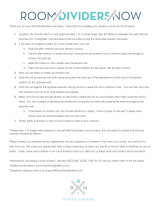
• Slo w do wn and use caution when making tur ns
and crossing roads and sidew alks .
• Do not operate the mac hine under the
influence of alcohol or dr ugs .
• Use care when loading or unloading the
mac hine into a trailer or tr uc k.
• Use care when approac hing blind cor ners ,
shr ubs , trees , or other objects that ma y obscure
vision.
• R ead all attac hment man uals .
• Ensure that the area is clear of other people
before operating the traction unit. Stop the
traction unit if any one enters the area.
• Nev er lea v e a r unning traction unit unattended.
Alw a ys lo w er the loader ar ms , stop the engine ,
set the parking brak e , and remo v e the k ey
before lea ving .
• Do not ex ceed the rated operating capacity , as
the traction unit ma y become unstable whic h
ma y result in loss of control.
• Do not car r y a load with the ar ms raised.
Alw a ys car r y loads close to the g round.
• Do not o v er -load the attac hment and alw a ys
k ee p the load lev el when raising the loader
ar ms . Logs , boards , and other items could roll
do wn the loader ar ms , injuring y ou.
• Nev er jerk the controls; use a steady motion.
• W atc h for traffic when operating near or
crossing roadw a ys .
• Do not touc h par ts whic h ma y be hot
from operation. Allo w them to cool before
attempting to maintain, adjust, or ser vice .
• Chec k for o v erhead clearances (i.e . branc hes ,
doorw a ys , electrical wires) before dri ving under
any objects and do not contact them.
• Ensure that y ou operate the traction unit in
areas where there are no obstacles in close
pro ximity to the operator . F ailure to maintain
adequate distance from trees , w alls , and other
bar riers ma y result in injur y as the traction unit
bac ks up during operation if the operator is not
attenti v e to the sur roundings . Only operate
the unit in areas where there is sufficient
clearance for the operator to safely maneuv er
the product.
• Before dig ging, ha v e the area mark ed for
underg round utilities , and do not dig in mark ed
areas .
• Locate the pinc h point areas mark ed on the
traction unit and attac hments and k ee p hands
and feet a w a y from these areas .
• Before operating the traction unit with an
attac hment, ensure that the attac hment is
properly installed.
Slope Operation
Slopes are a major factor related to loss-of-control
and tip-o v er accidents , whic h can result in sev ere
injur y or death. All slopes require extra caution.
• Do not operate the traction unit on hillsides
or slopes ex ceeding the angles recommended
in the Stability Data section in Specifications ,
pag e 17 , and those in the attac hment Operator’ s
Manual . See also the Slope Char t , pag e 8 .
• Operate up and do wn slopes with the
hea vy end of the traction unit uphill. W eight
distribution c hang es . An empty buc k et will
mak e the rear of the traction unit the hea vy
end, and a full buc k et will mak e the front of
the traction unit the hea vy end. Most other
attac hments will mak e the front of traction
unit the hea vy end.
• Raising the loader ar ms on a slope will affect
the stability of the mac hine . W henev er
possible , k ee p the loader ar ms in the lo w ered
position when on slopes .
• R emo ving an attac hment on a slope will mak e
the rear of the traction unit hea vy . R efer to
the Stability Data section in Specifications ,
pag e 17 , to deter mine whether the attac hment
can be safely remo v ed on the slope .
• R emo v e obstacles suc h as roc ks , tree limbs , etc .
from the w ork area. W atc h for holes , r uts , or
bumps , as unev en ter rain could o v er tur n the
traction unit. T all g rass can hide obstacles .
• Use only T oro-appro v ed attac hments .
Attac hments can c hang e the stability and
the operating c haracteristics of the traction
unit. W ar ranty ma y be v oided if used with
unappro v ed attac hments .
• K ee p all mo v ements on slopes slo w and
g radual. Do not mak e sudden c hang es in speed
or direction.
• A v oid star ting or stopping on a slope . If the
traction unit loses traction, proceed slo wly ,
straight do wn the slope .
5


























